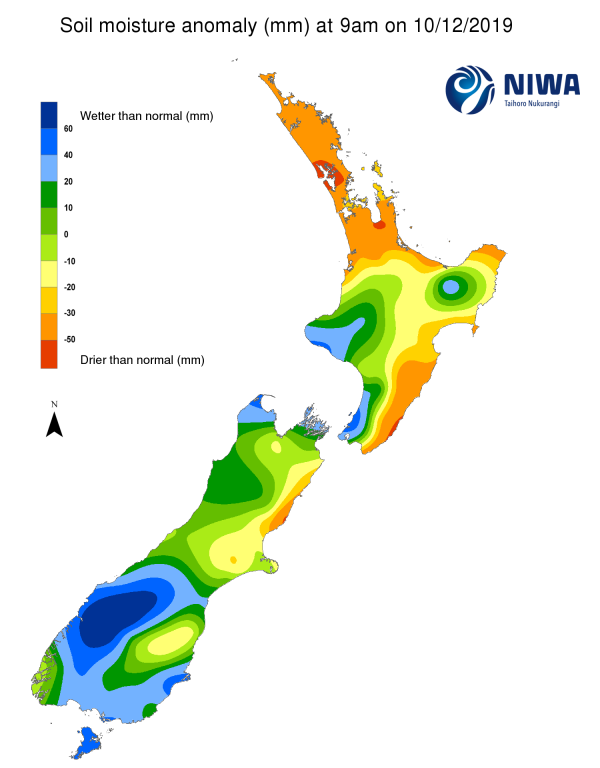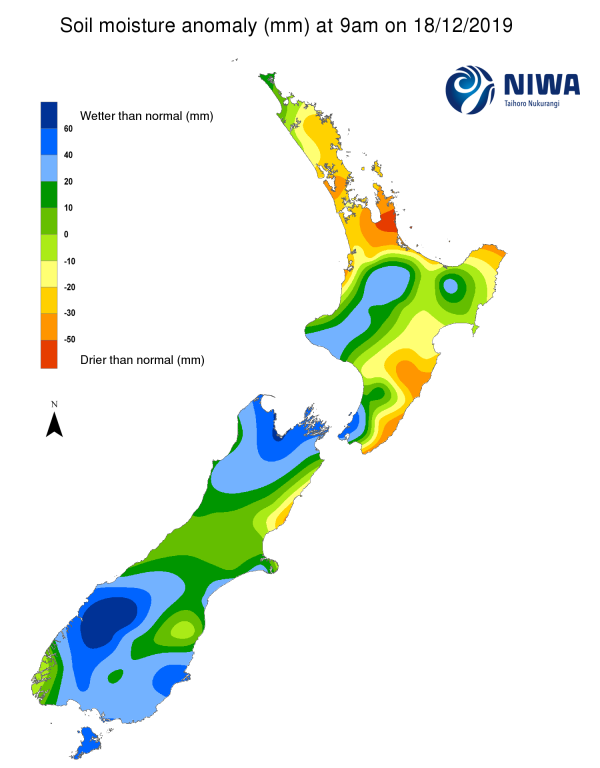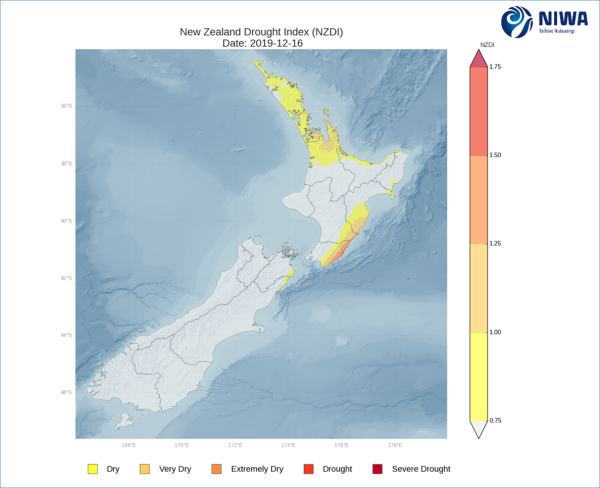A weekly update describing soil moisture across the country to help assess whether severely to extremely dry conditions are occurring or imminent. Regions experiencing these soil moisture deficits are deemed “hotspots”. Persistent hotspot regions have the potential to develop into drought.
Facts: soil moisture
Across the North Island, moderate to large increases in soil moisture levels were observed in many locations due to substantial rainfall in the past week. The most significant increases occurred in southern Waikato, the Central Plateau and in Northland. Conversely, a small decrease in soil moisture levels were observed in parts of the Hauraki and Thames-Coromandel Districts where North Island’s driest soil compared to normal is currently found. The wettest soil for this time of the year is located in the western Wellington Region.
Due to the increases in soil moisture levels, most of the Northland hotspots decreased in size or dissipated during the past week. However, hotspots still remain in northern Auckland, parts of the Hauraki and Thames-Coromandel Districts in the Coromandel, along with an area covering south coastal Hastings Districts south to Wairarapa.
Across the South Island, substantial rainfall contributed to moderate to large increases in soil moisture levels in the vast majority of the island. The most significant increases occurred in Tasman, Nelson and Marlborough, as well as in Canterbury and northern Otago. The driest soils across the South Island compared to normal for this time of the year are found in coastal Hurunui District, while the wettest soils for this time of the year are found in northern Fiordland and the Queenstown-Lakes District.
Due to the rainfall in the past week, most hotspots have dissipated. However, a hotspot still remains in coastal Hurunui District.
Outlook and soil moisture
In the North Island, a southerly change will move up the island on Friday (20 Dec) and bring rounds of heavy showers especially to western and central parts of the island. Mostly settled weather is expected this weekend and start to next week, with only isolated showers in the forecast. However, the threat of more widespread showers are expected to return to central and eastern areas on Tuesday and Wednesday (24-25 December).
Weekly rainfall totals up to 30 mm are expected in parts of the east, west, south and around the Central Plateau, with higher rainfall totals possible over higher terrain. Meanwhile, the upper North Island along with Hawke’s Bay and coastal Wairarapa may receive less than 20 mm of total rainfall. With the anticipated rainfall in the upcoming week, little or no change in soil moisture levels are expected from the south Waikato northbound, along with parts of southern Hawke’s Bay and coastal Wairarapa, while the rest of the North Island are expected to experience slight soil moisture increases.
The hotspots along the east coast and in Auckland will likely remain in place over the next week, while the hotspot in the Coromandel is expected to decrease in size.
In the South Island, a southerly change will bring moderate to heavy rain to western areas and showers to the south on Thursday (19 December). Showers are possible for large parts of the island on Friday (20 December) and blustery southwesterlies will keep the temperatures well below average for the time of year. Mostly dry conditions are expected over the weekend, but showers are expected in the south on Saturday evening, with rain developing in Fiordland and the lower West Coast on Sunday. A mostly settled start to the Christmas week is anticipated, but the threat of rain and showers will return, especially to the south and east, by mid-week.
Weekly rainfall totals in the west may reach 75 mm, with isolated parts of Fiordland and the West coast exceeding 100 mm. Up to 50 mm of total rainfall is possible in Southland, Otago, Canterbury high-country, and the Kaikoura Ranges, however coastal Canterbury may receive less than 20 mm.
Due to the anticipated rainfall, soil moisture levels will likely continue to increase in the west in the coming week, while smaller increases are expected in Southland, Otago, Tasman, and parts of Marlborough. However, soil moisture levels in costal Canterbury are expected to slightly decrease or remain unchanged in the upcoming week. This will likely result in small expansion of the current hotspots in the Hurunui District.
Background
Hotspot Watch: a weekly advisory service for New Zealand media. It provides soil moisture and precipitation measurements around the country to help assess whether extremely dry conditions are imminent.
Soil moisture deficit: the amount of water needed to bring the soil moisture content back to field capacity, which is the maximum amount of water the soil can hold.
Soil moisture anomaly: the difference between the historical normal soil moisture deficit (or surplus) for a given time of year and actual soil moisture deficits.
Definitions: “Extremely” and “severely” dry soils are based on a combination of the current soil moisture status and the difference from normal soil moisture. See soil moisture maps for more information.
Hotspot: A hotspot is declared if soils are "severely drier than normal" which occurs when Soil Moisture Deficit (SMD) is less than -110 mm AND the Soil Moisture Anomaly is less than -20 mm.


Pictured above: Soil Moisture Anomaly Maps, relative to this time of year. The maps show soil moisture anomaly for the past two weeks.
As of 16 December, the New Zealand Drought Index (NZDI) map below shows that very dry to extremely dry conditions are now located across coastal Wairarapa, and the Coromandel with dry conditions also in place in parts of Northland, Auckland, the Coromandel and costal Marlborough and northern Cantebury. Please note: some hotspots in the text above may not correspond with the NZDI map, mainly because the NZDI uses additional dryness indices including one which integrates the rainfall deficit over the past 60 days. Changes are therefore slower to appear in the NZDI compared to the instantaneous status maps of soil moisture anomaly.

